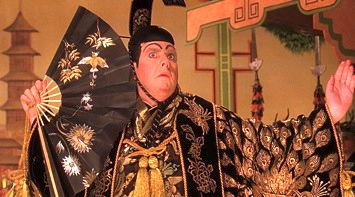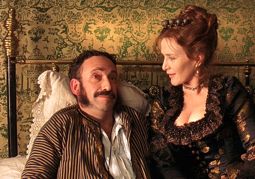 Topsy-turvy turned into a downer. “Princess Ida” came up short on charm. And so Gilbert & Sullivan’s partnership neared collapse.
Topsy-turvy turned into a downer. “Princess Ida” came up short on charm. And so Gilbert & Sullivan’s partnership neared collapse.
Such is the setup for Mike Leigh’s “Topsy Turvy,” the delightful 1999 biopic about the masters of comic opera and the making of their “The Mikado.”
The Criterion Collection has rereleased “Topsy-Turvy” on Blu-ray and DVD, accompanied by a just serving of extra features. Coming to market separately is Criterion’s debut of a 1939 Technicolor version of “The Mikado.”
Images on the “Topsy-Turvy” Blu-ray are lovely, especially in the second half when “The Mikado” is staged with luscious costumes and authentic period lighting. The DTS-HD surround soundtrack delivers crisp dialog and gracefully juggles the operettas’ vocal dynamics.
“Topsy-Turvy” runs almost three hours, a length arrived at after a “great struggle,” Leigh says in a interview filmed for the Criterion release. Somehow, that running time seems even a bit short, as Leigh serves up several films’ worth of intriguing subplots involving the original players and producers of “The Mikado.”
Allan Corduner quickly wins over the audience with his vibrant turn as composer Arthur Sullivan, but it is the more complex playwright W.S. Gilbert who attracted the director. “Gilbert was simply more interesting because he wasn’t such a nice guy,” Leigh says. Oh, and, “plainly he was sexually repressed.”
Gilbert is portrayed by Jim Broadbent, with whom Leigh made “Life Is Sweet” (1990). In 1992, they collaborated on a comic short film, “A Sense of History,” about a British earl telling secrets and lies. During shooting, they cooked up the idea for a Gilbert & Sullivan biopic. Amusing but unsettling, “Sense of History” is included as a bonus feature on the “Topsy-Turvy” Blu-ray.
 In the coming years — as with Gilbert & Sullivan, perhaps — Leigh had become typecast, as a maker of gritty films about working-class Brits ( “High Hopes,” “Naked”). He showed a lighter hand in “Career Girls” (1997) and then dove into production on “Topsy-Turvy.” The “closet Gilbert & Sullivan freak” spent years researching the men and Victorian London in the 1880s.
In the coming years — as with Gilbert & Sullivan, perhaps — Leigh had become typecast, as a maker of gritty films about working-class Brits ( “High Hopes,” “Naked”). He showed a lighter hand in “Career Girls” (1997) and then dove into production on “Topsy-Turvy.” The “closet Gilbert & Sullivan freak” spent years researching the men and Victorian London in the 1880s.
The leap back in time and up in class wasn’t all that odd, however. Leigh knew his stagecraft, having spent the 1960s studying theater and then directing plays. He’d worked two years with the Royal Shakespeare Company before moving on to direct televised plays.
Leigh finds similarities between his works and those of Gilbert & Sullivan: “We go to hell and back creating profound trivia for the laughing public.” He dismisses critics who saw “Topsy-Turvy” as a major departure, saying he was once again making a film about “real people doing real things.” The movie uses the upstairs/downstairs approach in order to spend time with the lesser-knowns behind the scenes of “The Mikado.”
The director’s encyclopedic knowledge of Gilbert & Sullivan and their “trivial souffles” becomes immediately evident upon hearing Leigh’s feature-length commentary for the film (recorded a decade ago for the initial DVD release). He says all American musical theater can be traced back to the comic operettas the Englishmen created in London in the late 1880s.
The duo’s home base, the Savoy Theatre, still exists, but couldn’t be used due to its art deco redesign. The production re-created the Savoy’s VIctorian-era appearance at another venue, no detail too small.
Leigh and musical director Gary Yershon auditioned opera singers for some of the lead roles but found them far too heavy, too loud. Most of the singers in “Topsy-Turvy” had no experience with opera, light or otherwise. Shirley Henderson (as Leonora Braham), they say, was a “Scottish folk singer.” Everyone involved in the production, including crew members, had to audition with a Gilbert & Sullivan song.
Leigh says he views the movie’s “most remarkable” scene as the one in which the creatively blocked Gilbert visits a Japanese trade expo and is inspired by the costumes and rituals to create “The Mikado.”
Criterion’s “Topsy-Turvy” discs include some deleted scenes (unfinished) and a contemporary documentary about the movie’s making. While there is duplication in the commentary, making-of feature and filmed interview, fans of the film shouldn’t hesitate to sample them all. Criterion regular Amy Taubin authors the booklet essay.
Leigh’s 2011 interview is done with music man Yershon, who earns his keep by describing the piano as the iPod of the Victorian Era.
Check out Glenn Abel on Google+



Leave a Reply